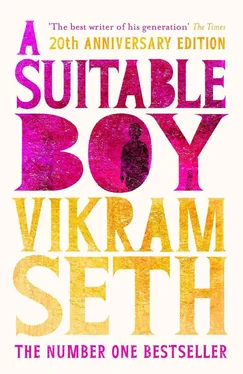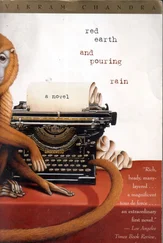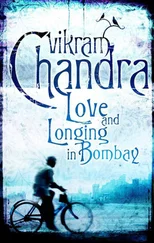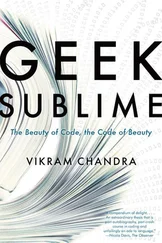Vikram Seth - A Suitable Boy
Здесь есть возможность читать онлайн «Vikram Seth - A Suitable Boy» весь текст электронной книги совершенно бесплатно (целиком полную версию без сокращений). В некоторых случаях можно слушать аудио, скачать через торрент в формате fb2 и присутствует краткое содержание. Год выпуска: 2012, Издательство: Orion Publishing Co, Жанр: Современная проза, на английском языке. Описание произведения, (предисловие) а так же отзывы посетителей доступны на портале библиотеки ЛибКат.
- Название:A Suitable Boy
- Автор:
- Издательство:Orion Publishing Co
- Жанр:
- Год:2012
- ISBN:нет данных
- Рейтинг книги:5 / 5. Голосов: 1
-
Избранное:Добавить в избранное
- Отзывы:
-
Ваша оценка:
- 100
- 1
- 2
- 3
- 4
- 5
A Suitable Boy: краткое содержание, описание и аннотация
Предлагаем к чтению аннотацию, описание, краткое содержание или предисловие (зависит от того, что написал сам автор книги «A Suitable Boy»). Если вы не нашли необходимую информацию о книге — напишите в комментариях, мы постараемся отыскать её.
A Suitable Boy — читать онлайн бесплатно полную книгу (весь текст) целиком
Ниже представлен текст книги, разбитый по страницам. Система сохранения места последней прочитанной страницы, позволяет с удобством читать онлайн бесплатно книгу «A Suitable Boy», без необходимости каждый раз заново искать на чём Вы остановились. Поставьте закладку, и сможете в любой момент перейти на страницу, на которой закончили чтение.
Интервал:
Закладка:
Inside, sitting on a cushion of white silk, was Raghubir Mehra’s gold medal for Engineering.
19.4
Twice that month did Mrs Rupa Mehra shuttle between Calcutta and Brahmpur.
She was so delighted to have the medal restored to her (‘The fact is, Madam, I could not bear to melt it down.’) that she bought it back instantly, drawing out whatever was necessary from her savings, and trying to economize slightly more on the necessary wedding expenses. She was — for a few days at least — entirely reconciled to Meenakshi and her ways. For if Meenakshi had not given Mr Jauhri this medal, it would have been stolen from the house in Sunny Park with the rest of the jewellery, and, like the Physics medal, would have vanished for good. Meenakshi too, when she got back from wherever it was she had been, looked happy and satisfied and was quite pleasant to her mother-in-law and Varun. When she heard about the medal she was not slow in claiming a perverse credit for events — and her mother-in-law did not object.
When Mrs Rupa Mehra got to Brahmpur she brought the medal with her and showed it triumphantly to everyone in the family, and everyone was delighted with her good fortune.
‘You must study hard, Lata, there are so few days left’—Mrs Rupa Mehra cautioned her daughter—‘or you will never have your Daddy’s academic success. You should not let your wedding and other things distract you.’ And with that she put Ideal Marriage , carefully wrapped in the bridal colours of red and gold, into her hands.
‘This book will teach you everything — about Men,’ she said, lowering her voice for some reason. ‘Even our Sita and Savitri had to have these experiences.’
‘Thank you, Ma,’ said Lata, a little apprehensively.
Mrs Rupa Mehra was suddenly embarrassed, and disappeared into the next room with the excuse that she had to phone her father.
Lata promptly unwrapped the package and, forgetting her studies, began to look through the Dutch sexologist’s advice. She was as much repelled as fascinated by what he had to offer.
There were numerous graphs describing the man’s and the woman’s degrees of excitement under different circumstances, for example, coitus interruptus and what the author called ‘Ideal Communion’. There were multicoloured, copiously labelled, not very appealing cross-sections of various organs. ‘Marriage is a science. (H. de Balzac)’ read the epigraph of the book, and Dr Van de Velde evidently took this aphorism seriously not only in his illustrations but also in his taxonomy. He divided what he shyly called his ‘Synousiology’ into converse and averse types, and further divided these into the habitual or medial attitude, the first attitude of extension, the second attitude of extension (suspensory), the attitudes of flexion (favoured, according to him, by the Chinese), the attitude of equitation (in which Martial described Hector and Andromache), the sedentary attitude, the anterior-lateral attitude, the ventral attitude, the posterior-lateral attitude, the attitude of averse flexion, and the posterior-sedentary attitude. Lata was amazed by the possibilities: she had only thought of one. (Indeed, even Malati had only ever mentioned one.) She wondered what the nuns at St Sophia’s would think of a book like this.
A footnote read as follows:
Arrangements have now been made for the manufacture of Dr Van de Velde’s Jellies (‘Eugam’): Lubricant, Contraceptive and Proconceptive. They are made by Messrs. Harman Freese, 32 Great Dover Street, London, S.E.1, who are also the makers of the author’s other preparations and pessaries (‘Gamophile’) referred to in ‘Fertility and Sterility in Marriage’.
From time to time Dr Van de Velde quoted approvingly the Dutch poet Cats, whose folk wisdom did not emerge well in translation:
Listen my friend, and know the reason why:
All beauty lies in the beholder’s eye.
But for all that, Lata was glad that her mother had cared enough for her to overcome her own embarrassment and put this book in her hands. She still had a few weeks to prepare herself for Life.
Lata looked thoughtful through most of dinner, glancing at Pran and Savita and wondering whether Savita too had received an Ideal Marriage before her wedding There was jelly for pudding, and to Mrs Rupa Mehra’s puzzlement — and everyone else’s — Lata began to laugh and would not explain why.
19.5
Lata took her final exams as if in a trance: sometimes she got the impression that she was someone other than herself. She felt she had done well, but this was combined with a curious, dislocated feeling — not like the panic of the previous year, but a sense that she was floating above her physical self and looking down on it from a height. Once, after a paper was over, she wandered down from the examination hall and sat on the bench beneath the gulmohur tree. Again the dark-orange flowers lay thick below her feet. Had it only been a year since she had met him?
If you love him so much, can you be happy to leave him miserable?
Where was he? Even if his exams were being held in the same building, he did not stand on the steps afterwards. He did not pass by the bench.
Just after the last paper, there was a concert by Ustad Majeed Khan, to which she went with Malati. Kabir was nowhere to be seen.
Amit had written her a brief note of congratulation, but — after their few moments in the bookshop and the coffee house — Kabir had as good as disappeared.
Whose life am I living? Lata wondered. Was my acceptance just a reaction?
Despite Haresh’s encouraging letters and her own cheerful replies, Lata began to feel both uncertain and very lonely.
Sometimes she sat on the banyan root and looked out over the Ganga, recollecting what it was pointless to recollect. Would she have been happy with him? Or he with her? He was so jealous now, so intense, so violent, so unlike the casual cricketer whom she had seen laughing and practising at the nets a year ago. How different he was now from the knight who had rescued her from the gulmohur bench and from Mr Nowrojee’s.
And I? she asked herself. How would I have acted in his place? With a jovial attempt at good fellowship? Even now I almost feel it’s he who’s left me — and I can’t bear it.
Two weeks more, she thought, and I will be the Bride of Goodyear Welted.
Oh, Kabir, Kabir — she wept.
I should run away, she thought.
I should run away, she thought, far from Haresh, far from Kabir, far from Arun and Varun and Ma and the whole Chatterji clan, far from Pran and Maan and Hindus and Muslims and passionate love and passionate hatred and all loud noises — just me and Malati and Savita and the baby.
We’ll sit on the sand on the other side of the Ganga and go to sleep for a year or two.
19.6
The wedding arrangements proceeded with great verve and much conflict. Mrs Rupa Mehra, Malati, Dr Kishen Chand Seth and Arun each tried to act as major-domo.
Dr Kishen Chand Seth insisted on asking Saeeda Bai to sing at the wedding. ‘Who else can one ask,’ he said, ‘when Saeeda Bai is in Brahmpur? Her throttling has opened her throat, they say.’
It was only when he realized that the entire Prem Nivas contingent would boycott the wedding that he relented. But by then he was off on to something else: the length of the list of invitees. It was too long, he claimed: his garden would be destroyed, his pockets emptied.
Everyone reassured him that they would be careful not to expand their own invitation list, and everyone went ahead and invited everyone they met. As for Dr Kishen Chand Seth, he was the worst offender of all: half the Subzipore Club and half the doctors of Brahmpur were invited, and almost anyone who had ever played bridge with him. ‘A wedding is always a time for settling scores,’ he explained cryptically.
Читать дальшеИнтервал:
Закладка:
Похожие книги на «A Suitable Boy»
Представляем Вашему вниманию похожие книги на «A Suitable Boy» списком для выбора. Мы отобрали схожую по названию и смыслу литературу в надежде предоставить читателям больше вариантов отыскать новые, интересные, ещё непрочитанные произведения.
Обсуждение, отзывы о книге «A Suitable Boy» и просто собственные мнения читателей. Оставьте ваши комментарии, напишите, что Вы думаете о произведении, его смысле или главных героях. Укажите что конкретно понравилось, а что нет, и почему Вы так считаете.











